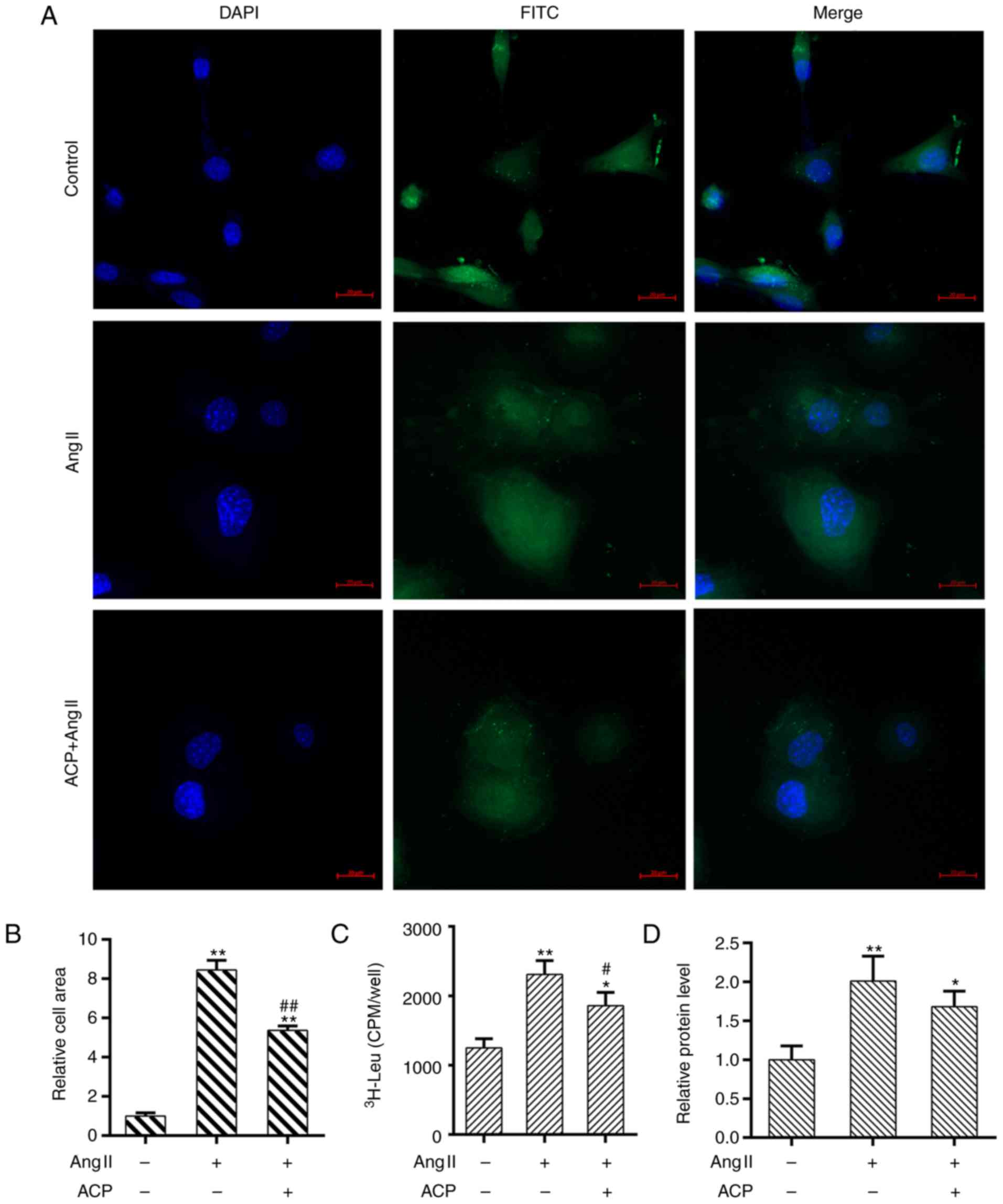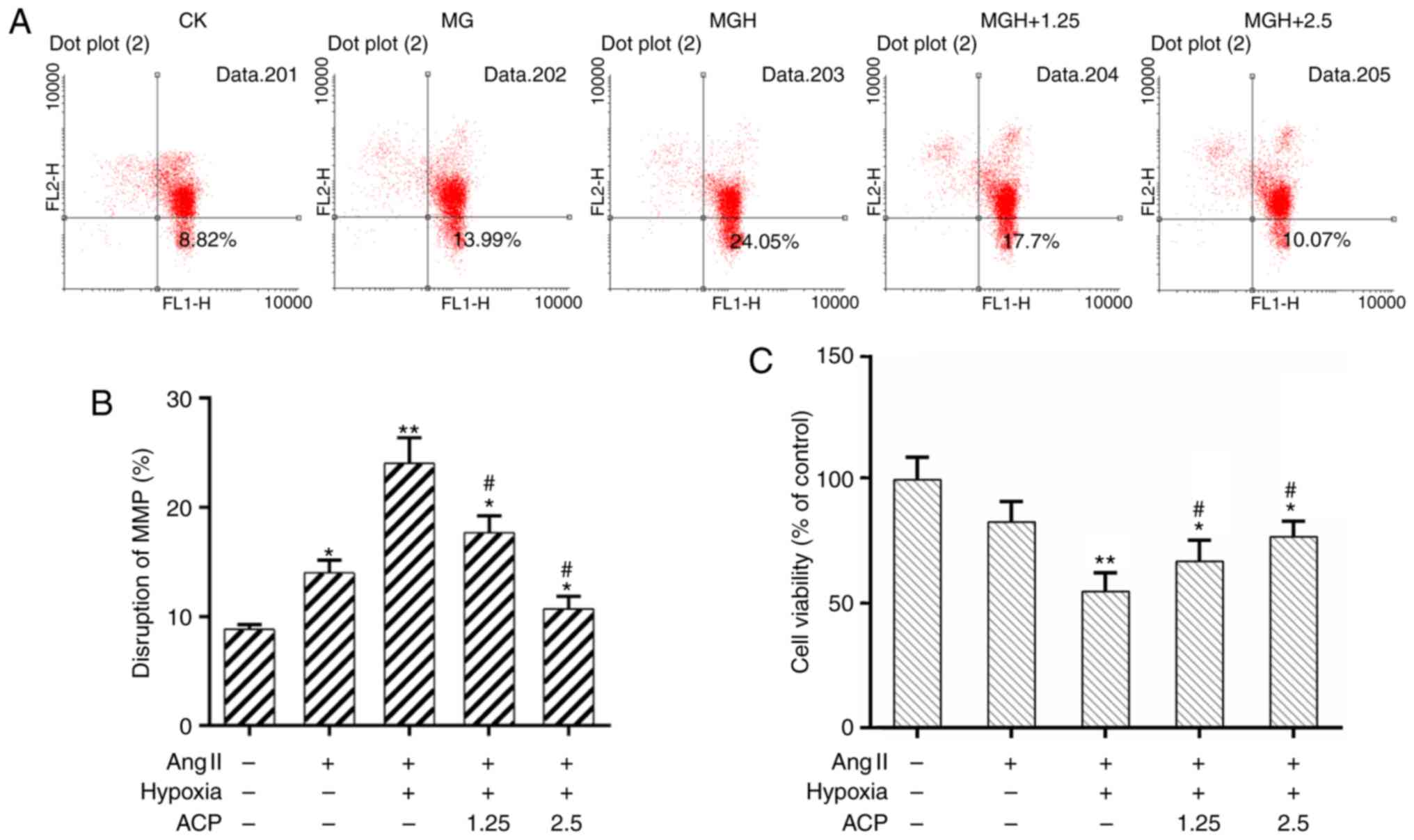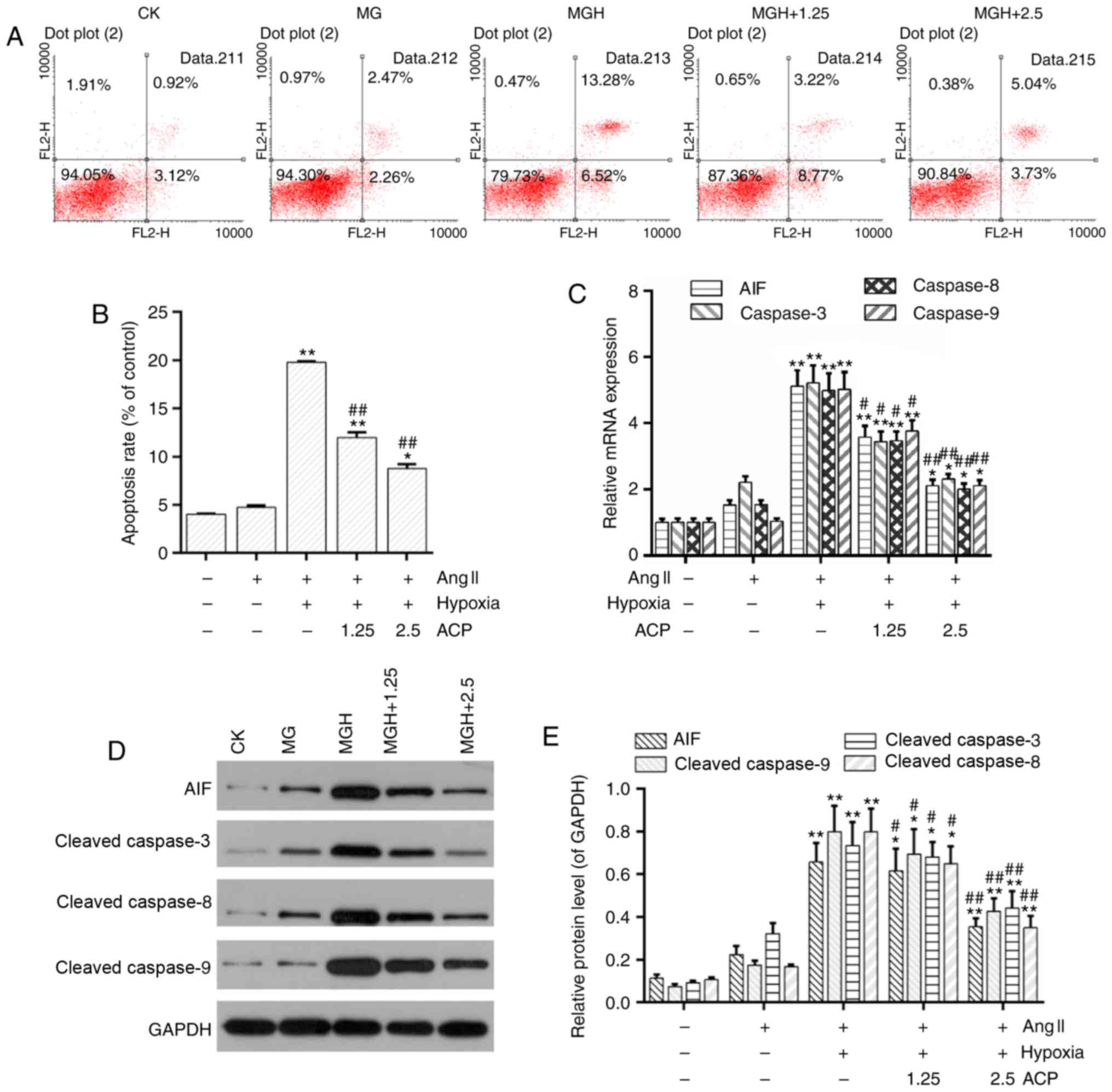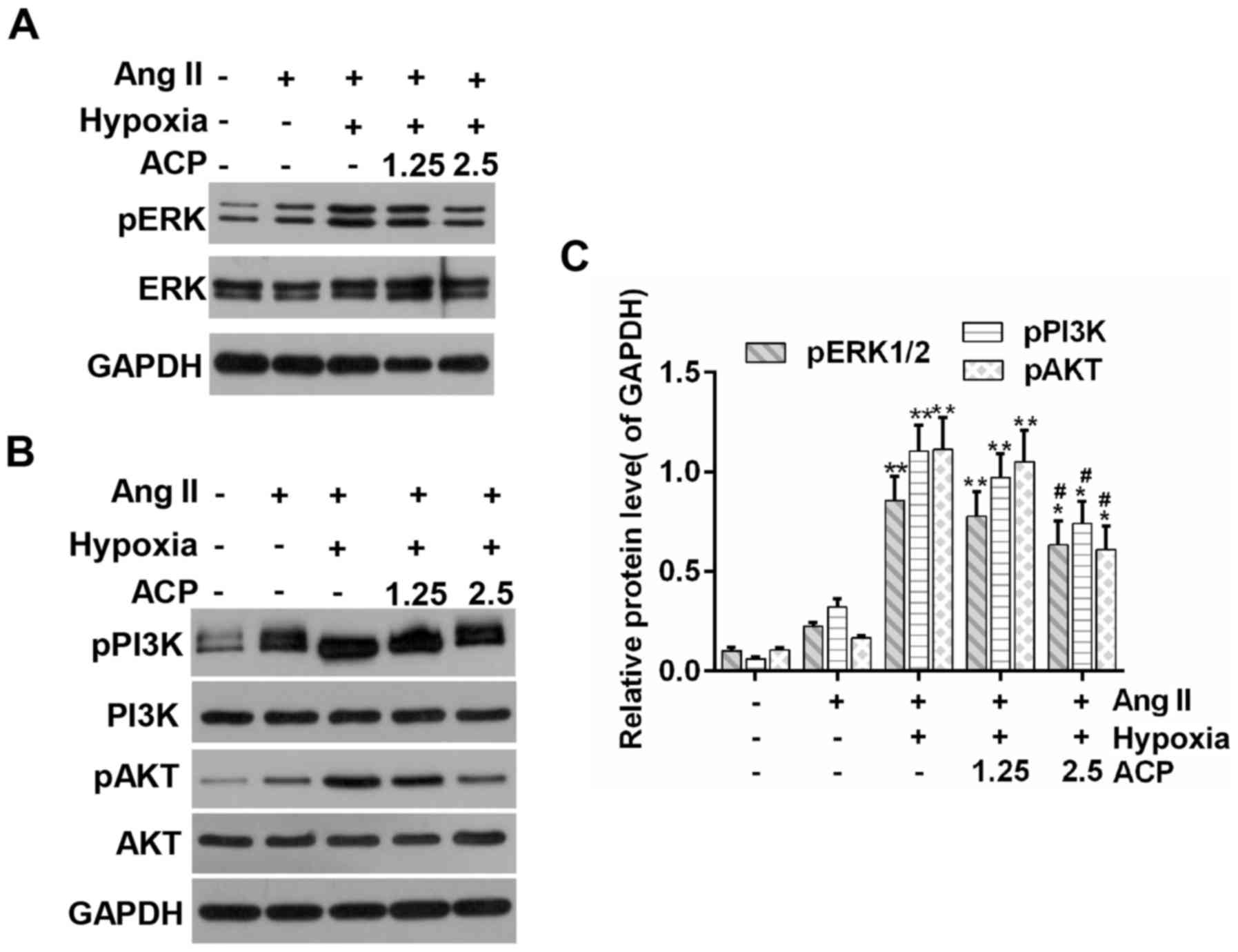|
1
|
Morrone D, Marzilli M, Kolm P and
Weintraub WS: Do clinical trials in ischemic heart disease meet the
needs of those with ischemia? J Am Coll Cardiol. 65:1596–1598.
2015. View Article : Google Scholar : PubMed/NCBI
|
|
2
|
Lozano R, Naghavi M, Foreman K, Lim S,
Shibuya K, Aboyans V, Abraham J, Adair T, Aggarwal R, Ahn SY, et
al: Global and regional mortality from 235 causes of death for 20
age groups in 1990 and 2010: A systematic analysis for the global
burden of disease study 2010. Lancet. 380:2095–2128. 2012.
View Article : Google Scholar : PubMed/NCBI
|
|
3
|
Sag CM, Santos CX and Shah AM: Redox
regulation of cardiac hypertrophy. J Mol Cell Cardiol. 73:103–111.
2014. View Article : Google Scholar : PubMed/NCBI
|
|
4
|
Fumarola C and Guidotti GG: Stress-induced
apoptosis: Toward a symmetry with receptor-mediated cell death.
Apoptosis. 9:77–82. 2004. View Article : Google Scholar : PubMed/NCBI
|
|
5
|
Zhou XF, Zhang P, Pi HF, Zhang YH, Ruan
HL, Wang H and Wu JZ: Triterpenoids from the roots of actinidia
chinensis. Chem Biodivers. 6:1202–1207. 2009. View Article : Google Scholar : PubMed/NCBI
|
|
6
|
Lim S, Han SH, Kim J, Lee HJ, Lee JG and
Lee EJ: Inhibition of hardy kiwifruit (Actinidia aruguta) ripening
by 1-methylcyclopropene during cold storage and anticancer
properties of the fruit extract. Food Chem. 190:150–157. 2016.
View Article : Google Scholar : PubMed/NCBI
|
|
7
|
Concha-Meyer AA, D'Ignoti V, Saez B, Diaz
RI and Torres CA: Effect of storage on the physico-chemical and
antioxidant properties of strawberry and kiwi leathers. J Food Sci.
81:C569–C577. 2016. View Article : Google Scholar : PubMed/NCBI
|
|
8
|
Lyon RC, Zanella F, Omens JH and Sheikh F:
Mechanotransduction in cardiac hypertrophy and failure. Circ Res.
116:1462–1476. 2015. View Article : Google Scholar : PubMed/NCBI
|
|
9
|
Maillet M, van Berlo JH and Molkentin JD:
Molecular basis of physiological heart growth: Fundamental concepts
and new players. Nat Rev Mol Cell Biol. 14:38–48. 2013. View Article : Google Scholar : PubMed/NCBI
|
|
10
|
Li Q, Wang F, Zhang YM, Zhou JJ and Zhang
Y: Activation of cannabinoid type 2 receptor by JWH133 protects
heart against ischemia/reperfusion-induced apoptosis. Cell Physiol
Biochem. 31:693–702. 2013. View Article : Google Scholar : PubMed/NCBI
|
|
11
|
Mitrega KA, Nozynski J, Porc M, Spalek AM
and Krzeminski TF: Dihydropyridines' metabolites-induced early
apoptosis after myocardial infarction in rats; new outlook on
preclinical study with M-2 and M-3. Apoptosis. 21:195–208. 2016.
View Article : Google Scholar : PubMed/NCBI
|
|
12
|
Qiu Q, Yang C, Xiong W, Tahiri H, Payeur
M, Superstein R, Carret AS, Hamel P, Ellezam B, Martin B, et al:
SYK is a target of lymphocyte-derived microparticles in the
induction of apoptosis of human retinoblastoma cells. Apoptosis.
20:1613–1622. 2015. View Article : Google Scholar : PubMed/NCBI
|
|
13
|
Thornberry NA and Lazebnik Y: Caspases:
Enemies within. Science. 281:1312–1316. 1998. View Article : Google Scholar : PubMed/NCBI
|
|
14
|
Santos N, Silva RF, Pinto M, Silva EBD,
Tasat DR and Amaral A: Active caspase-3 expression levels as
bioindicator of individual radiosensitivity. An Acad Bras Cienc. 89
1 Suppl 0:S649–S659. 2017. View Article : Google Scholar
|
|
15
|
McDougal AD and Dewey CF Jr: Modeling
oxygen requirements in ischemic cardiomyocytes. J Biol Chem.
292:11760–11776. 2017. View Article : Google Scholar : PubMed/NCBI
|
|
16
|
Yang Y, Ding S, Xu G, Chen F and Ding F:
MicroRNA-15a inhibition protects against
hypoxia/reoxygenation-induced apoptosis of cardiomyocytes by
targeting mothers against decapentaplegic homolog 7. Mol Med Rep.
15:3699–3705. 2017. View Article : Google Scholar : PubMed/NCBI
|
|
17
|
Dorn GW II and Force T: Protein kinase
cascades in the regulation of cardiac hypertrophy. J Clin Invest.
115:527–537. 2005. View
Article : Google Scholar : PubMed/NCBI
|
|
18
|
Sun J, Sun G, Meng X, Wang H, Luo Y, Qin
M, Ma B, Wang M, Cai D, Guo P, et al: Isorhamnetin protects against
doxorubicin-induced cardiotoxicity in vivo and in vitro. PLoS One.
8:e645262013. View Article : Google Scholar : PubMed/NCBI
|
|
19
|
Chanda D, Luiken JJ and Glatz JF:
Signaling pathways involved in cardiac energy metabolism. FEBS
Lett. 590:2364–2374. 2016. View Article : Google Scholar : PubMed/NCBI
|
|
20
|
Daskalopoulos EP, Dufeys C, Bertrand L,
Beauloye C and Horman S: AMPK in cardiac fibrosis and repair:
Actions beyond metabolic regulation. J Mol Cell Cardiol.
91:188–200. 2016. View Article : Google Scholar : PubMed/NCBI
|
|
21
|
Saxena A, Shinde AV, Haque Z, Wu YJ, Chen
W, Su Y and Frangogiannis NG: The role of Interleukin Receptor
Associated Kinase (IRAK)-M in regulation of myofibroblast phenotype
in vitro and in an experimental model of non-reperfused myocardial
infarction. J Mol Cell Cardiol. 89:223–231. 2015. View Article : Google Scholar : PubMed/NCBI
|
|
22
|
Sepuri NBV, Angireddy R, Srinivasan S,
Guha M, Spear J, Lu B, Anandatheerthavarada HK, Suzuki CK and
Avadhani NG: Mitochondrial LON protease-dependent degradation of
cytochrome c oxidase subunits under hypoxia and myocardial
ischemia. Biochimica Biophys Acta. 1858:519–528. 2017. View Article : Google Scholar
|
|
23
|
Huang P, Xu X, Wang L, Zhu B, Wang X and
Xia J: The role of EGF-EGFR signalling pathway in hepatocellular
carcinoma inflammatory microenvironment. J Cell Mol Med.
18:218–230. 2014. View Article : Google Scholar : PubMed/NCBI
|
|
24
|
Zhang M, Zhou Q, Liang QQ, Li CG, Holz JD,
Tang D, Sheu TJ, Li TF, Shi Q and Wang YJ: IGF-1 regulation of type
II collagen and MMP-13 expression in rat endplate chondrocytes via
distinct signaling pathways. Osteoarthritis Cartilage. 17:100–106.
2009. View Article : Google Scholar : PubMed/NCBI
|
|
25
|
Cai XY, Xia Y, Yang SH, Liu XZ, Shao ZW,
Liu YL, Yang W and Xiong LM: Ropivacaine- and bupivacaine-induced
death of rabbit annulus fibrosus cells in vitro: Involvement of the
mitochondrial apoptotic pathway. Osteoarthritis Cartilage.
23:1763–1775. 2015. View Article : Google Scholar : PubMed/NCBI
|
|
26
|
Kirchman D, K'Nees E and Hodson R: Leucine
incorporation and its potential as a measure of protein synthesis
by bacteria in natural aquatic systems. Appl Environ Microbiol.
49:599–607. 1985.PubMed/NCBI
|
|
27
|
Richards GP, Watson MA and Kingsley DH: A
SYBR green, real-time RT-PCR method to detect and quantitate
Norwalk virus in stools. J Virol Methods. 116:63–70. 2004.
View Article : Google Scholar : PubMed/NCBI
|
|
28
|
Du Z, Li S, Liu L, Yang Q, Zhang H and Gao
C: NADPH oxidase 3associated oxidative stress and caspase
3-dependent apoptosis in the cochleae of D-galactose induced aged
rats. Mol Med Rep. 12:7883–7890. 2015. View Article : Google Scholar : PubMed/NCBI
|
|
29
|
Arocho A, Chen B, Ladanyi M and Pan Q:
Validation of the 2-DeltaDeltaCt calculation as an alternate method
of data analysis for quantitative PCR of BCR-ABL P210 transcripts.
Diagn Mol Pathol. 15:56–61. 2006. View Article : Google Scholar : PubMed/NCBI
|
|
30
|
Livak KJ and Schmittgen TD: Analysis of
relative gene expression data using real-time quantitative PCR and
the 2(-Delta Delta C(T)) method. Methods. 25:402–408. 2001.
View Article : Google Scholar : PubMed/NCBI
|
|
31
|
Song WY, Xu GH and Zhang GJ: Effect of
Actinidia chinensis planch polysaccharide on the growth and
apoptosis and p-p38 expression in human gastric cancer SGC-7901
cells. Zhongguo Zhong xi yi jie he za zhi. 34:329–333. 2014.(In
Chinese). PubMed/NCBI
|
|
32
|
Verma P, Singh A, Nthenge-Ngumbau DN,
Rajamma U, Sinha S, Mukhopadhyay K and Mohanakumar KP: Attention
deficit-hyperactivity disorder suffers from mitochondrial
dysfunction. BBA Clin. 6:153–158. 2016. View Article : Google Scholar : PubMed/NCBI
|
|
33
|
Jamshidzadeh A, Heidari R, Abasvali M,
Zarei M, Ommati MM, Abdoli N, Khodaei F, Yeganeh Y, Jafari F, Zarei
A, et al: Taurine treatment preserves brain and liver mitochondrial
function in a rat model of fulminant hepatic failure and
hyperammonemia. Biomedicine Pharmacother. 86:514–520. 2017.
View Article : Google Scholar
|
|
34
|
Yan X, Wang L, Yang X, Qiu Y, Tian X, Lv
Y, Tian F, Song G and Wang T: Fluoride induces apoptosis in H9c2
cardiomyocytes via the mitochondrial pathway. Chemosphere.
182:159–165. 2017. View Article : Google Scholar : PubMed/NCBI
|
|
35
|
Liang W, Liao Y, Zhang J, Huang Q, Luo W,
Yu J, Gong J, Zhou Y, Li X, Tang B, et al: Heat shock factor 1
inhibits the mitochondrial apoptosis pathway by regulating second
mitochondria-derived activator of caspase to promote pancreatic
tumorigenesis. J Exp Clin Cancer Res. 36:642017. View Article : Google Scholar : PubMed/NCBI
|
|
36
|
Jeong JJ, Ha YM, Jin YC, Lee EJ, Kim JS,
Kim HJ, Seo HG, Lee JH, Kang SS, Kim YS and Chang KC: Rutin from
Lonicera japonica inhibits myocardial
ischemia/reperfusion-induced apoptosis in vivo and protects H9c2
cells against hydrogen peroxide-mediated injury via ERK1/2 and
PI3K/Akt signals in vitro. Food Chem Toxicol. 47:1569–1576. 2009.
View Article : Google Scholar : PubMed/NCBI
|
|
37
|
Fazal L, Laudette M, Paula-Gomes S, Pons
S, Conte C, Tortosa F, Sicard P, Sainte-Marie Y, Bisserier M,
Lairez O, et al: Multifunctional mitochondrial epac1 controls
myocardial cell death. Circ Res. 120:645–657. 2017. View Article : Google Scholar : PubMed/NCBI
|
|
38
|
Krech J, Tong G, Wowro S, Walker C,
Rosenthal LM, Berger F and Schmitt KRL: Moderate therapeutic
hypothermia induces multimodal protective effects in oxygen-glucose
deprivation/reperfusion injured cardiomyocytes. Mitochondrion.
35:1–10. 2017. View Article : Google Scholar : PubMed/NCBI
|
|
39
|
Roberts ER and Thomas KJ: The role of
mitochondria in the development and progression of lung cancer.
Comput Struct Biotechnol J. 6:e2013030192013. View Article : Google Scholar : PubMed/NCBI
|
|
40
|
Gharanei M, Hussain A, Janneh O and
Maddock HL: Doxorubicin induced myocardial injury is exacerbated
following ischaemic stress via opening of the mitochondrial
permeability transition pore. Toxicol Appl Pharmacol. 268:149–156.
2013. View Article : Google Scholar : PubMed/NCBI
|
|
41
|
Ahmed LA and El-Maraghy SA: Nicorandil
ameliorates mitochondrial dysfunction in doxorubicin-induced heart
failure in rats: Possible mechanism of cardioprotection. Biochem
Pharmacol. 86:1301–1310. 2013. View Article : Google Scholar : PubMed/NCBI
|
|
42
|
Susin SA, Lorenzo HK, Zamzami N, Marzo I,
Snow BE, Brothers GM, Mangion J, Jacotot E, Costantini P, Loeffler
M, et al: Molecular characterization of mitochondrial
apoptosis-inducing factor. Nature. 397:441–446. 1999. View Article : Google Scholar : PubMed/NCBI
|
|
43
|
Grutter MG: Caspases: Key players in
programmed cell death. Curr Opi Struct Biol. 10:649–655. 2000.
View Article : Google Scholar
|
|
44
|
Nasu K, Nishida M, Kawano Y, Tsuno A, Abe
W, Yuge A, Takai N and Narahara H: Aberrant expression of
apoptosis-related molecules in endometriosis: A possible mechanism
underlying the pathogenesis of endometriosis. Reprod Sci.
18:206–218. 2011. View Article : Google Scholar : PubMed/NCBI
|
|
45
|
Hu Y, Li L, Yin W, Shen L, You B and Gao
H: Protective effect of proanthocyanidins on anoxia-reoxygenation
injury of myocardial cells mediated by the PI3K/Akt/GSK-3beta
pathway and mitochondrial ATP-sensitive potassium channel. Mol Med
Rep. 10:2051–2058. 2014. View Article : Google Scholar : PubMed/NCBI
|
|
46
|
Wang Z, Zhang H, Xu X, Shi H, Yu X, Wang
X, Yan Y, Fu X, Hu H, Li X and Xiao J: bFGF inhibits ER stress
induced by ischemic oxidative injury via activation of the PI3K/Akt
and ERK1/2 pathways. Toxicol Lett. 212:137–146. 2012. View Article : Google Scholar : PubMed/NCBI
|
|
47
|
Manning BD and Cantley LC: AKT/PKB
signaling: navigating downstream. Cell. 129:1261–1274. 2007.
View Article : Google Scholar : PubMed/NCBI
|
|
48
|
Ramalingam M, Kwon YD and Kim SJ: Insulin
as a potent stimulator of Akt, ERK and inhibin-βE signaling in
osteoblast-like UMR-106 cells. Biomol Ther (Seoul). 24:589–594.
2016. View Article : Google Scholar : PubMed/NCBI
|
|
49
|
Pillai VB, Kanwal A, Fang YH, Sharp WW,
Samant S, Arbiser J and Gupta MP: Honokiol, an activator of
Sirtuin-3 (SIRT3) preserves mitochondria and protects the heart
from doxorubicin-induced cardiomyopathy in mice. Oncotarget.
8:34082–34098. 2017. View Article : Google Scholar : PubMed/NCBI
|
|
50
|
Los M, Maddika S, Erb B and
Schulze-Osthoff K: Switching Akt: From survival signaling to deadly
response. Bioessays. 31:492–495. 2009. View Article : Google Scholar : PubMed/NCBI
|
|
51
|
Coloff JL, Mason EF, Altman BJ, Gerriets
VA, Liu T, Nichols AN, Zhao Y, Wofford JA, Jacobs SR, Ilkayeva O,
et al: Akt requires glucose metabolism to suppress puma expression
and prevent apoptosis of leukemic T cells. J Biol Chem.
286:5921–5933. 2011. View Article : Google Scholar : PubMed/NCBI
|
|
52
|
Elstrom RL, Bauer DE, Buzzai M, Karnauskas
R, Harris MH, Plas DR, Zhuang H, Cinalli RM, Alavi A, Rudin CM and
Thompson CB: Akt stimulates aerobic glycolysis in cancer cells.
Cancer Res. 64:3892–3899. 2004. View Article : Google Scholar : PubMed/NCBI
|
|
53
|
Nogueira V, Park Y, Chen CC, Xu PZ, Chen
ML, Tonic I, Unterman T and Hay N: Akt determines replicative
senescence and oxidative or oncogenic premature senescence and
sensitizes cells to oxidative apoptosis. Cancer cell. 14:458–470.
2008. View Article : Google Scholar : PubMed/NCBI
|
|
54
|
Matsui T and Rosenzweig A: Convergent
signal transduction pathways controlling cardiomyocyte survival and
function: The role of PI 3-kinase and Akt. J Mol Cell Cardiol.
38:63–71. 2005. View Article : Google Scholar : PubMed/NCBI
|




















